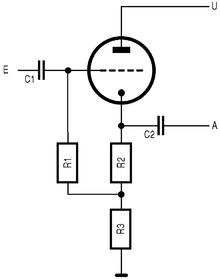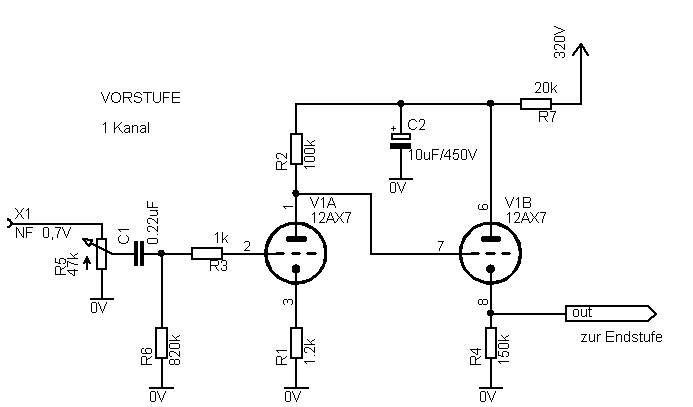PacoCasanovasOld
Fractal Fanatic
So once again, what is a cathode follower?
A magic circuit design , which squashed free electrons into cristal lattice? :lol
A circuit which introduced some kind of a preamp tube compression effect?
An impedance converter, to keep the signal level up when "loaded" with a "low impedance" tonestack?
Well, sort of - for the last two question the answer is yes!!......how comes a CF is not used in every amp design? Well to be honest - there are some wanted, and some "unwanted" side-effects of a cathode follower circuit. To be honest, regarding the impedance converter issue, a CF is not necessary needed. Cathode Followers were introduced in the 50s by Fender in their Tweet Series, those amps had a NFB (negative feedback) loop, but with fairly high on 56kOhms and so they need more signal to drive the power amp circuit - a cathode follower was needed, to prevent the signal drop because of a higher damping of the tonestack.
But there is a ugly (but some how wanted) truth about cathode followers! As we know, their gain factor is below 1, most people think this is not a gain stage - it's an impedance converter blahblahblah.... A cathode follower IS a gain stage, not neutral - it colours the sound, and introduces nonlinear clipping!!!
A cathode follower IS a gain stage, not neutral - it colours the sound, and introduces nonlinear clipping!!!
Speaking about a cathode follower, most people thinking about this:

there are tons of explanations on who this works....but as Cliff said, none came close....
Let's speak about this here:

This is a cathode follower in most common amp designs. It's a cathode bias together with a cathode follower together! There is grid current on the grid of the CF, which also affects the plate voltage of the cathode bias gain stage. The bias point of the CF is set by R4, if R4 would be 100K or even lower (such as on a VOX amp), the current goes up, so does the grid current on the CF - the internal resistance (which is equal the output impedance of a CF btw.) of the cathode follower goes up too, makes the cathode follower a nonlinear load for the previous cathode bias gain stage. Bottom of line - higher attack = higher signal = more current = more affection to the cathode bias gain stage by the CF as a nonlinear load = more nonlinear clipping! And it also depends on the tonestack and the value of the tonestack parameters...etc.
In other words: this is what Fw11 does!
So why there is no CF in many amp designs? Because it is not necessary needed on all designs and for all tonal characteristics.
In the past, there aren't tube scientists - good measuring equipment and scientific calculators were very expensive or not even there. Most circuits were copies of others or slight cosmetic corrections. There are some inventions, made by a misguided screwdriver in a circuit, that enlighten not just the workshop for a second lol ), it also enlighten many exploring minds. The basic marshall amp design was just a rip off of the tweed fender bassman circuit....later with a stronger power amp to fit the needs of the roaring loud sixties bands such as "The Who" and others...
lol ), it also enlighten many exploring minds. The basic marshall amp design was just a rip off of the tweed fender bassman circuit....later with a stronger power amp to fit the needs of the roaring loud sixties bands such as "The Who" and others...
In the beginning, amp distortion was unwanted, but later discovered as a wanted coloration - so most of the above side effect of a cathode follower was not planned by the designer back the years, it was unwanted, but sounded interesting - so it got copied many many times.....
BTW: Fender used 12AY7 tubes in the 50s they had a even lower open loop gain and also a lower internal resistance, which makes them not that grainy as the later 12AX7 tubes when using it in a CF circuit ( with more than two times the gain as a 12AY7). Fender even tried to lower the cathode follower non-linear clipping by using a negative feedback loop on their earlier tweet amps....the later tweet bassman has non such things. So does a marshall - and so it begun.....
So fender knew it, even back in the 50s.....
Have fun with Fw11!!
Cheers
Paco
A magic circuit design , which squashed free electrons into cristal lattice? :lol
A circuit which introduced some kind of a preamp tube compression effect?
An impedance converter, to keep the signal level up when "loaded" with a "low impedance" tonestack?
Well, sort of - for the last two question the answer is yes!!......how comes a CF is not used in every amp design? Well to be honest - there are some wanted, and some "unwanted" side-effects of a cathode follower circuit. To be honest, regarding the impedance converter issue, a CF is not necessary needed. Cathode Followers were introduced in the 50s by Fender in their Tweet Series, those amps had a NFB (negative feedback) loop, but with fairly high on 56kOhms and so they need more signal to drive the power amp circuit - a cathode follower was needed, to prevent the signal drop because of a higher damping of the tonestack.
But there is a ugly (but some how wanted) truth about cathode followers! As we know, their gain factor is below 1, most people think this is not a gain stage - it's an impedance converter blahblahblah....
Speaking about a cathode follower, most people thinking about this:

there are tons of explanations on who this works....but as Cliff said, none came close....
Let's speak about this here:

This is a cathode follower in most common amp designs. It's a cathode bias together with a cathode follower together! There is grid current on the grid of the CF, which also affects the plate voltage of the cathode bias gain stage. The bias point of the CF is set by R4, if R4 would be 100K or even lower (such as on a VOX amp), the current goes up, so does the grid current on the CF - the internal resistance (which is equal the output impedance of a CF btw.) of the cathode follower goes up too, makes the cathode follower a nonlinear load for the previous cathode bias gain stage. Bottom of line - higher attack = higher signal = more current = more affection to the cathode bias gain stage by the CF as a nonlinear load = more nonlinear clipping! And it also depends on the tonestack and the value of the tonestack parameters...etc.
In other words: this is what Fw11 does!
So why there is no CF in many amp designs? Because it is not necessary needed on all designs and for all tonal characteristics.
In the past, there aren't tube scientists - good measuring equipment and scientific calculators were very expensive or not even there. Most circuits were copies of others or slight cosmetic corrections. There are some inventions, made by a misguided screwdriver in a circuit, that enlighten not just the workshop for a second
In the beginning, amp distortion was unwanted, but later discovered as a wanted coloration - so most of the above side effect of a cathode follower was not planned by the designer back the years, it was unwanted, but sounded interesting - so it got copied many many times.....
BTW: Fender used 12AY7 tubes in the 50s they had a even lower open loop gain and also a lower internal resistance, which makes them not that grainy as the later 12AX7 tubes when using it in a CF circuit ( with more than two times the gain as a 12AY7). Fender even tried to lower the cathode follower non-linear clipping by using a negative feedback loop on their earlier tweet amps....the later tweet bassman has non such things. So does a marshall - and so it begun.....
So fender knew it, even back in the 50s.....
Have fun with Fw11!!
Cheers
Paco
Last edited:




